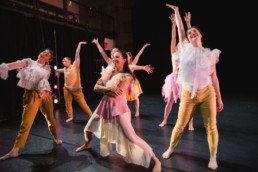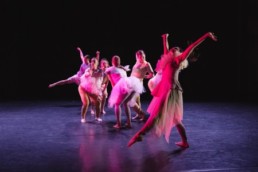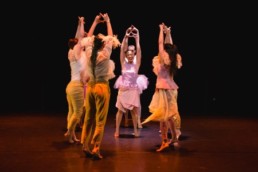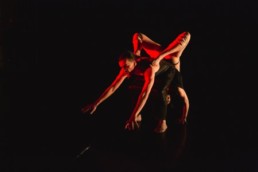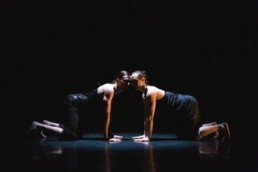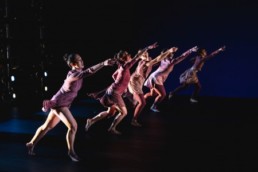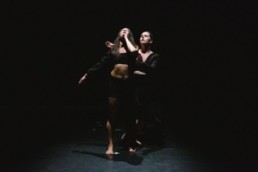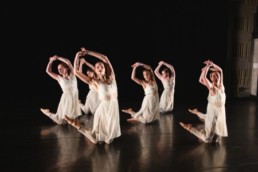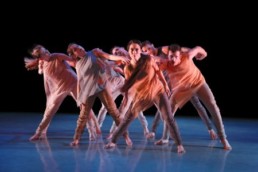Ariel Rivka Dance (with Guests slowdanger and Alison Cook Beatty Dance)
Baruch Performing Arts Center
New York, New York
March 28, 2019
Ariel Rivka Dance: Rhapsody in K, She, Mossy, Ori
slowdanger: memory 6
Alison Cook Beatty Dance: Magnetic Temptations
Jerry Hochman
Ariel Rivka Dance presented its annual New York season last week, inviting additional companies to join them on each night of the four-program run at the new Baruch Performing Arts Center. I saw the opening night program, which included pieces by slowdanger and Alison Cook Beatty Dance. The evening demonstrated, yet again, that unexpectedly interesting and well-crafted dances can be found in nooks and crannies everywhere in New York.
With the exception of those ARD pieces I’ve previously seen and reviewed, which I won’t comment on further, I’ll consider the dances in order of presentation.
As a choreographer, Ariel Grossman’s craft turned a corner several years ago with her presentation of Ori, and continues to show noteworthy growth, including successfully choreographing subjects that might be considered beyond the boundaries of dance craftsmanship or audience interest. Last year Grossman presented She, a dance about post-partum depression largely accompanied by the sound of a breast pump. To my surprise, I found it to be a compelling and insightful piece of work.
This year, Grossman, whose recent choreographic efforts have centered around her two children, was based on movement qualities observed in one of them – her 4½ year old daughter. Wonderful, I sarcastically thought to myself: a dance with a lot of jumping up and down, running around, and unfocussed limb flailing, and reflecting a two minute attention span to boot. Well, Rhapsody in K certainly has a lot of jumping up and down, running around, and unfocussed limb flailing. But there’s more to it than that, and except for one crotchety critical observation, it’s one of Grossman’s most accomplished dances.
The dance begins almost too cute, with one of ARD’s female dancers, outfitted like an overgrown 4 ½ year old and moving like an overgrown 4½ year old to a child’s recorded words and sounds (presumably those of Grossman’s 4½ year old daughter Eva). When that segment ends, the “real” dance begins. To a composition by Stefania de Kenessey (the same composer who created the score for She) and company Executive Director / Composer David Homan (who is also the choreographer’s husband), played effervescently by violinist Rebecca Cherry, Grossman takes those initial themes that her daughter provided and creates a series of themes and variations for a company of seven super-sized kindergartners (which, presumably, is where the “K” in the dance’s title came from). The style – the movement, expressions, and attitude – is child-like, but the choreography is coherent and engaging, and never takes the 4ish exuberance too far over the top — on the contrary, it relies on the fact that many in the audience have seen this movement before, and that part of the appeal of Rhapsody in K is its trip down memory lane. The “children” assemble and reassemble in distinctive lines and patterns, “perform” sequential movement (or sequential variations on a basic movement), break out into smaller subgroups and into dance solos that not only fit appropriately but that serve to cleanse the visual palette. The movement quality, while clearly based on her daughter’s “improvisations,” looks far more natural than many pieces of contemporary dance that I’ve seen. Marianna Tsartolia’s costumes successfully embrace childish klutz and adult/child kitsch (or maybe it’s the other way around), and with the violin played from a level above the stage area echoing against the theater’s bare walls, the dance’s atmosphere is bathed in a sort of heavenly musical glow. All in all, it’s not only a hoot – which is the best that I’d expected – but a highly accomplished piece of work.
That crotchety criticism: it goes on too long, with too many false endings. Just when you think that, when Hana Ginsburg Tirosh’s child character does her solo dance and announces “All Done,” that “all done” means “all done,” the dance continues through another segment or two before a final group of oversized children announces “all done” in unison. Some parts of it could have been cut – but I recognize that choosing to eliminate part of an artistic creation may be roughly equivalent to choosing from among one’s children.
I can’t think of a more contrasting piece to follow Rhapsody in K than slowdanger’s memory 6. There are no program notes, so my only knowledge of the dance is from what was presented on stage. But after burying my head in my hands for the first few minutes of it, I ended up being thoroughly impressed.
slowdanger is a “multidisciplinary performance entity” based in Pittsburgh, co-founded by co-artistic directors anna thompson and taylor knight. memory 6 is performed by thompson and knight, to music by thompson and knight, with costumes by thompson. I confess that I have a prejudice against companies or individuals who insist on presenting themselves with a lowercase initial letter – I assume it’s done to emphasize that in their minds they’re no more significant than anyone else, but it has the effect of accomplishing just the opposite – drawing attention to themselves.
Be that as it may, memory 6 begins with one standing dancer, back to the audience and dressed in what appears to be a woman’s black dress, writhing in apparent agony. I assumed it was thompson, until a body emerged from the darkness stage left, and I saw it was a woman wearing a similar black dress. thompson approached the standing person, who turned (and, not surprisingly at that point, it was knight), and the pair then began a dance that explored the duality symbolized by their almost identical costumes.
Portraying two sides of one individual, or suggesting that there’s no difference between genders, or displaying the agony of being born one sex and believing oneself to be the other, or exploring the nature of an unusually confusing but emotionally powerful relationship, or permutations of any or all of them, has been done before. [Or maybe, given its title, the dance is about breaking away from the memory of a relationship, or the memory of a prior life.] But after getting over the intentional deception and focusing on the choreography, exactly what thompson and knight are trying to portray becomes less important than how they’re doing it, and the choreography here – the passion and pain of this relationship, whatever the nature of that relationship may be – is so intense, and so well-executed, that ultimately the reason behind it doesn’t matter. That being said, it would have been nice to have had a clue.
Following a reprise of Grossman’s She, which on second view looks even more accomplished and powerful than it did previously, ARD presented the evening’s second world premiere, Mossy. To another composition by De Kenessey, Grossman here creates a duet that, according to the program note, “reflects the physical, emotional and intellectual consequences of constant interruption,” from a mother’s perspective. While I enjoyed the piece as a relatively abstract expression of dependence and independence, I was less sanguine about the communication of Grossman’s intent. I could see the emotional turmoil, but I couldn’t see the cause of it; I saw nothing that I could connect to a mother’s constant interruption. Indeed, the presence of two women in the piece makes little sense (with respect to Grossman’s stated intent) unless one posits that the two women are really depictions of the same woman whose life and personal identity has been torn apart, in which case the cause of the inner turmoil might be considered irrelevant. But if the turmoil is to be considered in a context, something more is needed. Again, however, as an expression of two women’s inexplicable inner turmoil, the dance was very well crafted, and very movingly executed by Caitlyn Casson and Casie O’Kane.
Before the evening concluded with ARD’s reprise of Grossman’s Ori, Alison Cook Beatty Dance, a company I’d not previously seen, presented Magnetic Temptations, a powerful though not entirely successful piece of work danced magnificently by the company’s eight dancers. There’s nothing wrong with the Artistic Director Alison Cook-Beatty’s choreography – in fact, much of it is quite impressive, with a combined lyrical / balletic and contemporary edge, but it’s too repetitious (which is caused by the nature of the subject) and too long (which is caused by the score).
Without knowing more than what was presented on stage, I saw Magnetic Temptations as a mystical dance that explores the ability to overcome destructive emotional forces, like tempting sirens, through the power of prayer. To me, the accompanying music sounded Buddhist, or maybe Islamic, since the sound was vaguely Middle-Eastern – something like an extended call to prayer or to battle inner demons, or both. I believe I’m right as to the first part of that – in my view, that kind of spiritual battle against “magnetic temptations” is what Cook-Beatty was choreographing, but I was completely wrong about the musical source.
Following the program, I found that the score selected by Cook-Beatty, Grá agus Bás, by Donnacha Demehy, is an example of historic Irish melismatic music that Demehy, a contemporary Irish singer / composer / musician, and associate artists created, at least in part, to both rekindle and celebrate the style. In melismatic music, vowel sounds are carried over two or more musical notes that vary in pitch and duration. And it does have a connection to religious music – it’s a characteristic of sacred songs of Middle-Eastern origin (Islamic; Jewish), as well as Gregorian chant.
I’m not a music scholar, but to my ear, where some melismatic music sounds uplifting either by itself or in connection with dispassionately conveying a narrative, other examples can sound musically one-dimensional and aurally irritating (which may be how it’s supposed to sound), with minimal sound variety, no rhythm, and little in the way of melodic development. I suppose that one’s reaction to it depends, to a large extent, on one’s cultural background and exposure. That’s a long-winded way of explaining why, although many commentators have found Grá agus Bás to be not just an attempt to resuscitate a mostly forgotten Irish style (“sean-nos,” which means “old style”) and an extraordinary accomplishment, I found it withering. I’ll grant, though, that it grows in texture and timbre as it approaches its end – it just takes a long time (over 25 minutes) to get there.
Translated, “Grá agus Bás” means “Love and Death.” I didn’t find a translation of the lyrics, but that title, combined with the music’s sound quality, is certainly sufficient to inspire the visualization of psycho-religious battle for the soul. I found much of Cook-Beatty’s choreography to be thrilling to watch, with an emphasis on images of the central character, Timothy Ward, confronting and battling forces that adhere to his body, and by extension his soul, like magnets. These forces are primarily, to me, depicted as sexual temptations (ergo, the dance’s title), a conclusion difficult to avoid since much of the dance consists of the company’s female dancers hurling themselves at Ward like sirens, or furies, or a plague of attractive locusts, and wrapping their bodies around his until he fights them off – only to have them regroup and attack again. They’re relentless. I suspect that Cook-Beatty didn’t intend to limit the temptations to that one temptation – the pervasive sirens are probably visual metaphors for a host of destructive impulses.
Except for the choreography for Ward, which I found relatively uninteresting (he’s possessed by these destructive forces, tries to run from them, runs backward in circles a lot for reasons not at all clear to me, occasionally reaches up as if praying for some supreme being’s assistance, and otherwise appears as a victim of persistent and unyielding tempting assaults), the choreography for the remaining seven dancers is imaginative and visually fascinating to watch – to a point. After awhile, however, one tires of seeing the same movement, however interesting it may be, repeated over and over (or appear to be), for no apparent reason beyond the fact that the music doesn’t end.
And when, finally, Grá agus Bás reaches its minimalist crescendo, the dance finally ends – with Ward stomping into the ground and the furies that controlled him thereupon disappearing. All he had to do was stomp his feet? It took 25 or so minutes for him to figure that out? Of course that’s not fair – it often takes people lifetimes to overcome inner demons and temptations that they find impossible to ignore. But the audience shouldn’t have to wait that long before a dance’s hero, or “everyperson,” conquers the personal demons that torment him.
The company’s dancers are a solid and engaging group, but I must admit that my focus was almost constantly on the women, who seemed in continual, feverish motion and to be everywhere at once. That they’re also very good at what Cook-Beatty has them do is a bonus. In addition to Ward, the company’s dancers included Carolina Rivera, Fiona Oba, Vera Paganin, Sasha Rydlizky, Niccolo Orsolani, Jacob Brown, and Richard Sayama. While I have quibbles about Magnetic Temptations, Alison Cook Beatty Dance is now on my radar.
Finally, I must again commend ARD for sharing its program with companies of such high caliber. It not only enhances the evening for the audience, it enhances ARD’s pieces by association. And I must also salute the eight companies that joined ARD on these programs, particularly since each had only one performance opportunity. Based on this program, they made the most of it. The other guest companies included Tina Croll + Company, 277 Dance Project (both on Friday’s program), Beth Liebowitz/Beth & Artists, Kyleigh Sackandy, and mignolo dance (on Saturday’s matinee program), and Amma/Amanda Krische and Valerie Green/Dance Entropy (on Saturday evening).
Author: Jerry Hochman
Source: https://criticaldance.org/ariel-rivka-dance-guests-childs-play-adult-turmoil/


